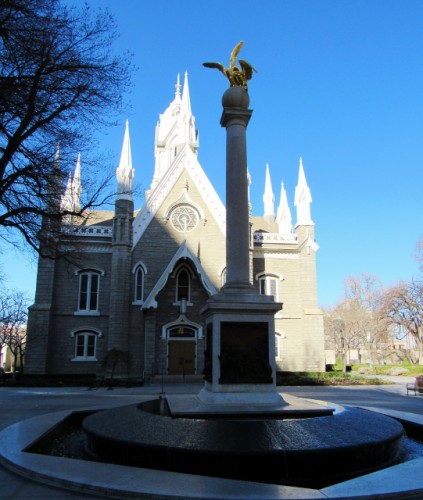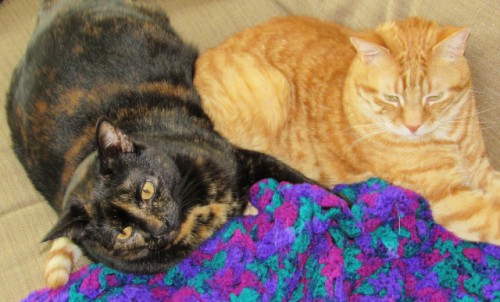If you had a morning to do some sightseeing in downtown Salt Lake City, where would you go?
We began our day at Temple Square to see the Salt Lake Temple, arguably the most famous Mormon Temple in the world. Non-Mormons are not allowed inside, but you can tour the grounds and check out some of the other buildings. We strolled around for a short while to get some photos of the Temple, the Assembly Hall and the Mormon Tabernacle Choir building. The choir practices in the afternoon, but we didn’t want to hang around that long.

The Assembly Hall at Temple Square – Built 1880 – Gothic Revival Architectural Style

A Burst of Color Early in the Season
The Salt Lake Temple took over 40 years to build – it was started in 1853 and was completed in 1893. It was designed by Truman O. Angell, one of Brigham Young’s brother-in-laws, who was also the architect for the Lion House and the Beehive House. Construction originally began with sandstone, but had to be halted during the Utah War – the foundation blocks were buried to avoid being a target during the conflict. If you haven’t heard of the Utah War, it is the conflict between the Mormons and the U.S. Military that led to the massacre of 120 California bound settlers by the Mormons that is known as the Mountain Meadows Massacre. But I don’t want to get into that here.
When they resumed building after the Utah War, they discovered that the sandstone had cracked, so they replaced much of the sandstone with gray quartz monzonite and built with it going forward. The stone has the look of granite. The temple is 222 feet tall and has several ornate pinnacles. The temple is absolutely stunning and so large that it is next to impossible to get it all in one photo.

The Salt Lake Temple – Built 1853-1893

A statue commemorating the fact that many Mormon Pioneers made the journey on foot with their only belongings in a hand cart.
After the temple, we walked two blocks down the street, past the Mormon Church Administrative Offices, and saw the Lion House and the Beehive House. They are next door to one another and were built by the Mormons for Brigham Young. The Lion House was built in 1856, and has 20 bedrooms. It was named for the large statuary lion that sits above the door, although some say the lion is there because Brigham Young’s nickname was the lion.

The Lion House – Built 1856
The Lion House housed several of Brigham Young’s 55 wives and 57 children, in a long three story building with 20 bedroom suites along long main hallways on the second and third floors. The basement houses a dining room that is open to the public today. It serves comfort food, but no alcohol or caffeine, in keeping with Mormon customs. Only the dining room is open to the public, but the Mormon church rents the Lion House out for events, so you can sneak a peak at the interior on their website.

The detail of the lion on the Lion House
Next door is the Beehive House, which was Brigham Young’s office, as well as being the residence for one of Brigham Young’s most senior wives and her nine children. It was built between 1853 and 1856. A brief 20 minute tour is available for free, provided by Mormon missionaries, called Sisters, who serve as docents for the tour. I warned Jon ahead of time that the docents are known to proselytize, and after originally saying he wanted to wait outside, Jon grudgingly agreed to do the tour with me. “You can put up with it for 20 minutes,” I said, “For me.” What a guy!

The Beehive House – Built 1853-1856 – Greek Revival Architectural Style
Our docents were from Arizona and Italy. They let you know at the beginning of the tour that they will be sharing information about their faith, but didn’t give the hard sell to anyone on our tour (there were six of us). We wandered around the rooms, stopping briefly in each one, admiring the furniture and hearing some brief information about the Mormon belief system.

The beehive detail on the top of the Beehive House
Our docents did not know much beyond the script of their faith. They didn’t know who designed or built the Beehive House, whether any of the furniture was original, or even how many wives or children Brigham Young had (although I do suspect they might be instructed to tell tourists they don’t know the answer to the wives/children question, in order to distance the Mormon church from its controversial polygamist history).

The interior of the Beehive House
All in all, it was a historic home tour unlike any other I’ve experienced. The home was really just the backdrop for the explanation of their faith, rather than the star of the show.
I would have preferred if they would have explained why they built the home with a beehive on the top, or beehive accents in the home (the newel posts are carved beehives). The beehive has been a religious symbol of industriousness since Roman times, and the word Deseret, used by the Mormons to describe their proposed territory during the 1800s, means honeybee.
It also would have been nice if the sisters explained anything about the business that Brigham Young conducted from the home, or when it ceased to be a home and office and became a “museum.” But, based on the reviews I had read, I really didn’t expect much history from the tour, so it is hard to be very disappointed. To be clear, all of the historical information in this post was gleaned from the internet.
Our last stop of the morning was a couple of blocks down the street, at the Cathedral of the Madeleine, Salt Lake City’s Catholic Cathedral. It is stunning, constructed in the Neo-Romanesque style in 1909, with the most exquisite gargoyles flying off the towers. We didn’t go inside, instead just admiring the outside for a few minutes before heading on our way.

Cathedral of the Madeleine – Built 1909 – Neo-Romanesque Architectural Style

One of the towers of the Cathedral of the Madeleine, with its flying Gargoyles.

The detail of one of the Cathedral’s Gargoyles
With that, we headed back to the car, which was still parked in the hotel garage, and headed out for the almost four hour drive to Moab.













































